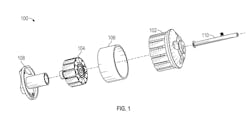Patent Filing Indicates Tesla's Material Progress
Tesla Motors has once again made clear its interest in metalcasting technology, filing a patent application for a new series of aluminum alloys that the automaker claims can maintain high-yield strength while achieving high conductivity. More than this, the “high-performance diecastable aluminum alloys” described by Tesla also have “a high flowability and low susceptibility to hot tearing when diecast.”
The filing is titled, “New Generation of Eutectic Al-Ni Casting Alloys for Elevated Temperature Services”. According to Tesla’s description, these new alloys are suitable for aluminum diecasting, but green-sand casting, permanent-mold casting, investment casting, “or any other casting techniques may be used”.
Previous to this application, the EV developer and manufacturer also filed a patent for a “Multi-Directional Unibody Casting Machine for a Vehicle Frame and Associated Methods,” aiming to cast aluminum auto bodies as a single piece, to replace dozens of parts that require welding and other fabricating steps.
It’s also notable that Tesla founder Elon Musk previously recruited materials expert Charles Kuehmann from Apple Inc. to coordinate development of new alloys for Tesla and his SpaceX venture. Kuehmann at one time was a principal with Questek Innovations LLC.
The recent patent filing addresses a highly recognizable problem for automotive and metalcasting engineers — the design limitations of metal alloys, in particular the lightweight alloys that are so much in demand for automotive design.
“For certain applications, for example, parts within an electric vehicle like a rotor or an inverter, both high-strength and conductivity are desired,” Tesla continues.
The problem continues, however. The desired alloy must be suitable for casting, “such that the parts may be cast quickly and reliably, such as through a low-pressure and high-velocity metal injection or a high-pressure diecasting process.
“After casting, suitable alloys must maintain their properties sufficiently for the necessary application. Poor castability of the alloy often results in observed hot tearing, and can cause fill issues which typically decreases the mechanical and electrical properties of the end cast part,” the application further noted.
According to Tesla’s filing, the new aluminum alloys it has developed can be modified as necessary to achieve yield strengths from 90 to 150 MPa and electrical conductivity from 40% to 60% IACS. For example, during diecasting the new alloys can achieve sufficient fluidity to ensure that metal fills a mold entirely, so that parts are formed properly. More than this, the alloys also resist hot-tearing and retain their yield strength after the metal is solidified.
The filing also gives a glimpse of the metallurgy involved in the new material, including that it may include 4.0-6.0% nickel, providing “high yield strength and high electrical conductivity compared to conventional, commercially available aluminum alloys.”
“Nickel formed a eutectic with aluminum at approximately 6% weight,” the application explains, “whereby cerium and silicon formed a eutectic with aluminum at greater weight percentages. Because it is desirable to include a larger percentage of aluminum in the aluminum alloy for its desirable tensile strength and conductivity, the addition of nickel was found to be more desirable than the addition of cerium.”
As an automaker, Tesla Motors is still working to produce vehicles in high volume. But, as a material and process developer, Tesla’s patent applications show that it understands what metalcasters know: that quality and productivity are equally demanding goals.

